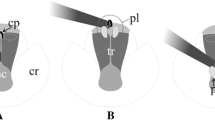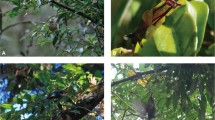Abstract
Pollination studies of South African Asclepiadeae (Apocynaceae: Asclepiadoideae) have mostly examined species in the moist summer-rainfall grasslands, with limited studies of the early-diverging groups occurring in the drier winter-rainfall habitats. This study examined the pollination and floral traits of Eustegia minuta, an unusual species endemic to the winter-rainfall Greater Cape Floristic Region and representing an early-diverging clade within the Asclepiadeae. Observations of floral visitors in Jonkershoek Nature Reserve showed that this species is visited primarily by a species of March fly, Bibio turneri (Bibionidae). These flies moved actively between plants and carried pollinaria on their mouthparts. In addition, an ant species, Camponotus vestitus (Formicidae), and a single honey bee Apis mellifera capensis (Apidae) individual carried pollinaria and may contribute to pollination. Bagging experiments confirmed that flowers require pollinators for reproduction. Flowers produced small amounts (1.2 µl per flower) of concentrated (32.5% sugar) nectar. Pollination success was low (14.5% of flowers were pollinated and 3.4% of flowers developed fruits). Pollen transfer efficiency (PTE) was 5.2%. The corolla reflectance was similar to that of green leaves, but the gynostegium exhibited a relatively bright human-white spectral curve. Floral scent comprised over 50 compounds, but was dominated by various aromatics along with 2,3-heptandione, (E)-4,8-dimethylnona-1,3,7-triene and several unidentified compounds. We conclude that E. minuta is pollinated primarily by the March fly B. turneri, although ants and possibly honey bees may make a lesser contribution. Pollination by bibionid flies has not previously been reported in asclepiads and is extremely uncommon amongst angiosperms.



Similar content being viewed by others
Data availability
The datasets generated during and/or analysed during the current study are available from the corresponding author on reasonable request.
References
Aak A, Knudsen GK (2011) Sex differences in olfaction-mediated visual acuity in blowflies and its consequences for gender-specific trapping. Entomol Exp Appl 139:25–34
Beattie AJ (2006) The evolution of ant pollination systems. Botanische Jahrbücher 127:43–55
Beattie AJ, Turnbull C, Knox RB, Williams E (1984) Ant inhibition of pollen function: a possible reason why ant pollination is rare. Am J Bot 71:421–426
Bruyns P (1999) The systematic position of Eustegia R Br(Apocynaceae-Asclepiadoideae). Botanische Jahrbücher 121:19–44
Burger H, Jürgens A, Ayasse M, Johnson SD (2017) Floral signals and filters in a wasp-and a bee-pollinated Gomphocarpus species (Apocynaceae: Asclepiadeae). Flora 232:83–91
Clarke KR, Warwick R (2001) Change in marine communities: an approach to statistical analysis and interpretation, 2nd edn. Primer-E Ltd, Plymouth
Coombs G, Peter CI, Johnson SD (2009) A test for Allee effects in the self-incompatible wasp-pollinated milkweed Gomphocarpus physocarpus. Austral Ecol 34:688–697
Cruden RW (1972) Pollination biology of Nemophila menziesii (Hydrophyllaceae) with comments on the evolution of oligolectic bees. Evolution 26:373–389
Domingos-Melo A, de Lima Nadia T, Machado IC (2017) Complex flowers and rare pollinators: does ant pollination in Ditassa show a stable system in Asclepiadoideae (Apocynaceae)? Arthropod-Plant Interact 11:339–349
du Plessis M, Johnson SD, Nicolson SW, Bruyns PV, Shuttleworth A (2018) Pollination of the “carrion flowers” of an African stapeliad (Ceropegia mixta: Apocynaceae): the importance of visual and scent traits for the attraction of flies. Plant Syst Evol 304:357–372
Endress ME, Liede-Schumann S, Meve U (2014) An updated classification for Apocynaceae. Phytotaxa 159:175–194
Goldblatt P, Manning JC, Bernhardt P (2005) The floral biology of Melasphaerula (Iridaceae: Crocoideae): is this monotypic genus pollinated by March flies (Diptera: Bibionidae)? Ann Mo Bot Garden 92:268–274
Hardy DE (1950) A monographic study of the African Bibionidae (Diptera). Part I: introduction and genus Bibio Geoffroy. J Kans Entomol Soc 23:137–153
Heine E (1937) Observations on the pollination of New Zealand flowering plants. Trans Proc R Soc NZ 2:133–148
Higham R, McQuillan P (2000) Cyathodes divaricata (Epacridaceae)—the first record of a bird-pollinated dioecious plant in the Australian flora. Aust J Bot 48:93–99
Huang Y, Zhang C-Q, Blackmore S, Li D-Z, Wu Z-K (2006) A preliminary study on pollination biology of Omphalogramma souliei Franch. (Primulaceae), a species endemic to China. Plant Syst Evol 261:89–98
Johnson SD (2010) The pollination niche and its role in the diversification and maintenance of the southern African flora. Philos Trans Roy Soc B 365:499–516
Johnson SD, Steiner KE (1994) Efficient pollination of the mass-flowering Cape orchid Disa obtusa Lindl. (Orchidaceae) by Bibio turneri Edwards (Diptera: Bibionidae). Afr Entomol 2:64–66
Johnson SD, Steiner KE (2003) Specialized pollination systems in southern Africa. S Afr J Sci 99:345–348
Johnson SD, Peter CI, Agren J (2004) The effects of nectar addition on pollen removal and geitonogamy in the non-rewarding orchid Anacamptis morio. Proc R Soc Lond B 271:803–809
Jürgens A, Dötterl S, Meve U (2006) The chemical nature of fetid floral odours in stapeliads (Apocynaceae-Asclepiadoideae-Ceropegieae). New Phytol 172:452–468
Jürgens A, Dötterl S, Liede-Schumann S, Meve U (2008) Chemical diversity of floral volatiles in Asclepiadoideae-Asclepiadeae (Apocynaceae). Biochem Syst Ecol 36:842–852
Jürgens A, Dötterl S, Liede-Schumann S, Meve U (2010) Floral scent composition in early diverging taxa of Asclepiadoideae, and Secamonoideae (Apocynaceae). S Afr J Bot 76:749–761
Knudsen JT, Eriksson R, Gershenzon J, Stahl B (2006) Diversity and distribution of floral scent. Bot Rev 72:1–120
Lehnebach CA, Robertson AW (2004) Pollination ecology of four epiphytic orchids of New Zealand. Ann Bot 93:773–781
Liede S (1997) Subtribes and genera of the tribe Asclepiadeae (Apocynaceae, Asclepiadoideae)—a synopsis. Taxon 46:233–247
Liede S (2001) Subtribe Astephaninae (Apocynaceae-Asclepiadoideae) reconsidered: new evidence based on cpDNA spacers. Ann Mo Bot Garden 88:657–668
Manning JC, Goldblatt P (2012) Plants of the Greater Cape Floristic Region 1: the Core Cape Region. Strelitzia 29. South African National Biodiversity Institute, Pretoria
Medan D, Montaldo NH, Devoto M, Mantese A, Vasellati V, Roitman GG, Bartoloni NH (2002) Plant-pollinator relationships at two altitudes in the Andes of Mendoza, Argentina. Arct Antarct Alp Res 34:233–241
Meve U, Liede S (2004) Subtribal division of Ceropegieae (Apocynaceae-Asclepiadoideae). Taxon 53:61–72
Ollerton J, Johnson SD, Cranmer L, Kellie S (2003) The pollination ecology of an assemblage of grassland asclepiads in South Africa. Ann Bot 92:807–834
Ollerton J, Liede-Schumann S, Endress ME, Meve U, Rech AR, Shuttleworth A, Keller HA, Fishbein M et al (2019) The diversity and evolution of pollination systems in large plant clades: Apocynaceae as a case study. Ann Bot 123:311–325
Pauw A (1998) Pollen transfer on birds’ tongues. Nature 394:731–732
Peter CI, Shuttleworth A (2014) Catching on to concatenation: evidence for pre-pollination intrasexual selection in plants. New Phytol 203:4–6
Primack RB (1983) Insect pollination in the New Zealand mountain flora. NZ J Bot 21:317–333
Rapini A, Chase MW, Goyder DJ, Griffiths J (2003) Asclepiadeae classification: evaluating the phylogenetic relationships of New World Asclepiadoideae (Apocynaceae). Taxon 52:33–50
Rapini A, van den Berg C, Liede-Schumann S (2007) Diversification of Asclepiadoideae (Apocynaceae) in the New World. Ann Mo Bot Garden 94:407–422
Shaw DC, Taylor RJ (1986) Pollination ecology of an alpine fell-field community in the North Cascades. Northwest Sci 60:21–31
Shuttleworth A (2016) Smells like debauchery: the chemical composition of semen-like, sweat-like and faintly foetid floral odours in Xysmalobium (Apocynaceae: Asclepiadoideae). Biochem Syst Ecol 66:63–75
Shuttleworth A, Johnson SD (2009a) The importance of scent and nectar filters in a specialized wasp-pollination system. Funct Ecol 23:931–940
Shuttleworth A, Johnson SD (2009b) Specialized pollination in the African milkweed Xysmalobium orbiculare: a key role for floral scent in the attraction of spider-hunting wasps. Plant Syst Evol 280:37–44
Shuttleworth A, Johnson SD (2009c) New records of insect pollinators for South African asclepiads (Apocynaceae: Asclepiadoideae). S Afr J Bot 75:689–698
Shuttleworth A, Johnson S (2010) Floral scents of chafer-pollinated asclepiads and a potential hybrid. S Afr J Bot 76:770–778
Shuttleworth A, Johnson SD (2012) The Hemipepsis wasp-pollination system in South Africa: a comparative analysis of trait convergence in a highly specialized plant guild. Bot J Linn Soc 168:278–299
Shuttleworth A, Johnson SD, Jürgens A (2017) Entering through the narrow gate: a morphological filter explains specialized pollination of a carrion-scented stapeliad. Flora 232:92–103
Snijman DA (ed) (2013) Plants of the Greater Cape Floristic Region 2: the extra Cape Flora. Strelitzia 30. South African National Biodiversity Institute, Pretoria
Straub SCK, Cronn RC, Edwards C, Fishbein M, Liston A (2013) Horizontal transfer of DNA from the mitochondrial to the plastid genome and its subsequent evolution in milkweeds (Apocynaceae). Genome Biol Evol 5:1872–1885
Surveswaran S, Sun M, Grimm GW, Liede-Schumann S (2014) On the systematic position of some Asian enigmatic genera of Asclepiadoideae (Apocynaceae). Bot J Linn Soc 174:601–619
Vergara CH, Badano EI (2009) Pollinator diversity increases fruit production in Mexican coffee plantations: the importance of rustic management systems. Agric Ecosyst Environ 129:117–123
Wall R, Fisher P (2001) Visual and olfactory cue interaction in resource-location by the blowfly, Lucilia sericata. Physiol Entomol 26:212–218
Wyatt R, Broyles SB (1994) Ecology and evolution of reproduction in milkweeds. Ann Rev Ecol Syst 25:423–441
Acknowledgements
We would like to thank John Skartveit and Peter Slingsby for assistance with the identification of the bibionids and ants respectively; Alex Hall, Alison Bijl and Sean Evans for assistance in the field; Steve Johnson for access to the GC-MS equipment; and, Timo van der Niet and two anonymous reviewers for comments on an earlier version of the manuscript. AS, SLS and YC thank the National Research Foundation of South Africa for funding (Grant Numbers 91441 and 90691). Finally, we would like to thank Jonkershoek Nature Reserve and CapeNature for access to the study site.
Author information
Authors and Affiliations
Corresponding author
Ethics declarations
Conflict of interest
The authors declare that they have no conflict of interest.
Additional information
Handling Editor: Kristine Nemec.
Rights and permissions
About this article
Cite this article
Chirango, Y., Steenhuisen, SL., Bruyns, P.V. et al. The March fly and the ant: the unusual pollination system of Eustegia minuta (Apocynaceae: Asclepiadoideae). Arthropod-Plant Interactions 13, 745–755 (2019). https://doi.org/10.1007/s11829-019-09675-2
Received:
Accepted:
Published:
Issue Date:
DOI: https://doi.org/10.1007/s11829-019-09675-2




